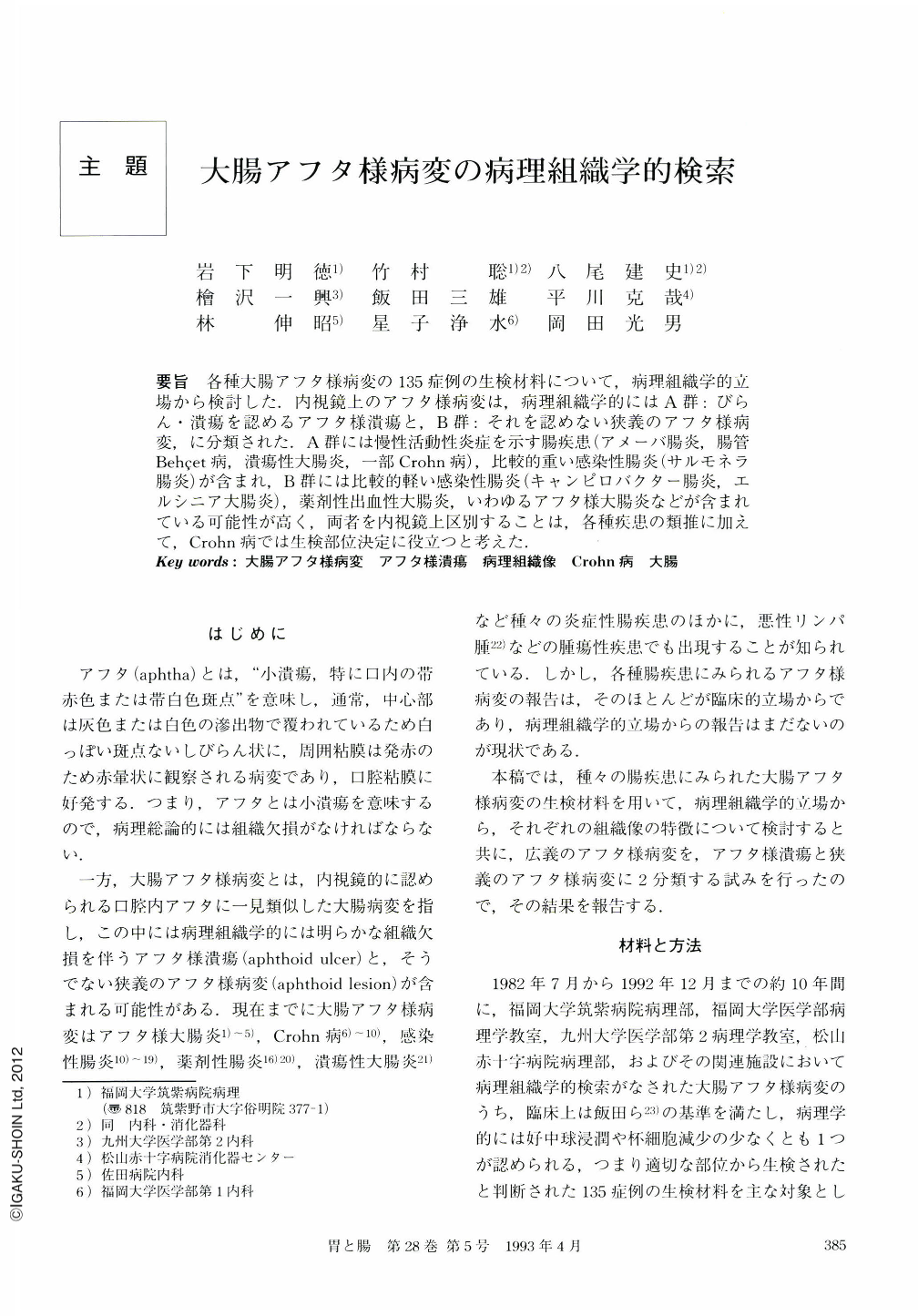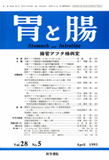Japanese
English
- 有料閲覧
- Abstract 文献概要
- 1ページ目 Look Inside
- サイト内被引用 Cited by
要旨 各種大腸アフタ様病変の135症例の生検材料について,病理組織学的立場から検討した.内視鏡上のアフタ様病変は,病理組織学的にはA群:びらん・潰瘍を認めるアフタ様潰瘍と,B群=それを認めない狭義のアフタ様病変,に分類された.A群には慢性活動性炎症を示す腸疾患(アメーバ腸炎,腸管Behget病,潰瘍性大腸炎,一部Crohn病),比較的重い感染性腸炎(サルモネラ腸炎)が含まれ,B群には比較的軽い感染性腸炎(キャンピロバクター腸炎,エルシニア大腸炎),薬剤性出血性大腸炎,いわゆるアフタ様大腸炎などが含まれている可能性が高く,両者を内視鏡上区別することは,各種疾患の類推に加えて,Crohn病では生検部位決定に役立つと考えた.
To evaluate aphthoid lesions of the large intestine from the histopathological standpoints, we analyzed 135 biopsy specimens from 135 patients with various intestinal diseases. The results were as follows:
1) Endoscopically proved aphthoid lesions were divided into 2 groups based on the presence of histopathologically proved ulcerative changes. Group A: with ulcerative lesions (111 lesions), group B: without ulcerative lesions (24 lesions).
2) Biopsy specimens obtained from 21 patients with Crohn's disease showed epithelioid cell granulomas (61.9%) and Paneth cell metaplasia (52.4% for all cases, 28.6% for left colonic lesions). Granulomas were more common in group A (75%) than in group B (58.8%). Seventeen out of 21 lesions belonged to group B.
3) Campylobacter colitis was histopathologically characterized by acute mild inflammation with fresh hemorrhage. Eight out of nine lesions belonged to group B.
4) The biopsy specimens obtained from Salmonella colitis showed acute inflammation with marked destruclion of the glands. Both of two lesions belonged to group A.
5) The microscopic feature of Yersinia colitis was acute mild inflammation. There was a case of Yersinia colitis accompanied by two small granulomas with a few neutrophils. All 8lesions belonged to group B.
6) The histopathologic feature of amebic colitis was Entamoeba histolytica in the liquefactive necrotic material and chronic but active inflammation with relatively many eosinophils. All 6 lesions belonged to group A.
7) The biopsy specimens from drug-induced hemorrhagic colitis showed fresh hemorrhage and acute mild inflammation. All 6 lesions belonged to group B.
8) The microscopic feature of intestinal Behget's disease was chronic but active, and moderate inflammation. Two out of 3 lesions belonged to group A.
9) The aphthoid lesions of malignant lymphoma and adult T-cell leukemia had lymphoid follicle-like struclures being composed of atypical lymphoid cells. All 4 lesions belonged to group B.
1O) The microscopic feature of probable ulcerative colitis was chronic but active, and moderate inflammation. There were crypt abcesses (50%), relatively prominent goblet cell depletion and Paneth cell metaplasia (30%). Five out of 10 lesions belonged to group A.
11) The histopathologic feature of so-called aphthoid colitis was acute mild inflammation. All 34 lesions belonged to group B.
Endoscopically proved aphthoid lesions of the large intestine were divided into two groups. The lesions with ulcerative changes (aphthoid ulcers) were caused by amebic colitis, intestinal Behget's disease, possibie ulcerative colitis, Salmonella colitis and a part of Crohn's disease. The other group, lesions without ulcerative changes, consisted of Campylobacter colitis,Yersinia colitis, drug-induced hemorrhagic colitis. There fore, this classification would be useful for endo scopic differential diagnosis of aphthoid lesions of the large intestine.

Copyright © 1993, Igaku-Shoin Ltd. All rights reserved.


